Contract Practice Assignment 2022
VerifiedAdded on 2022/10/11
|11
|4513
|24
Assignment
AI Summary
Contribute Materials
Your contribution can guide someone’s learning journey. Share your
documents today.

Contract Practice
[Name]
[Module Coordinator]
[Course/School of………….]
[Date]
[Name]
[Module Coordinator]
[Course/School of………….]
[Date]
Secure Best Marks with AI Grader
Need help grading? Try our AI Grader for instant feedback on your assignments.
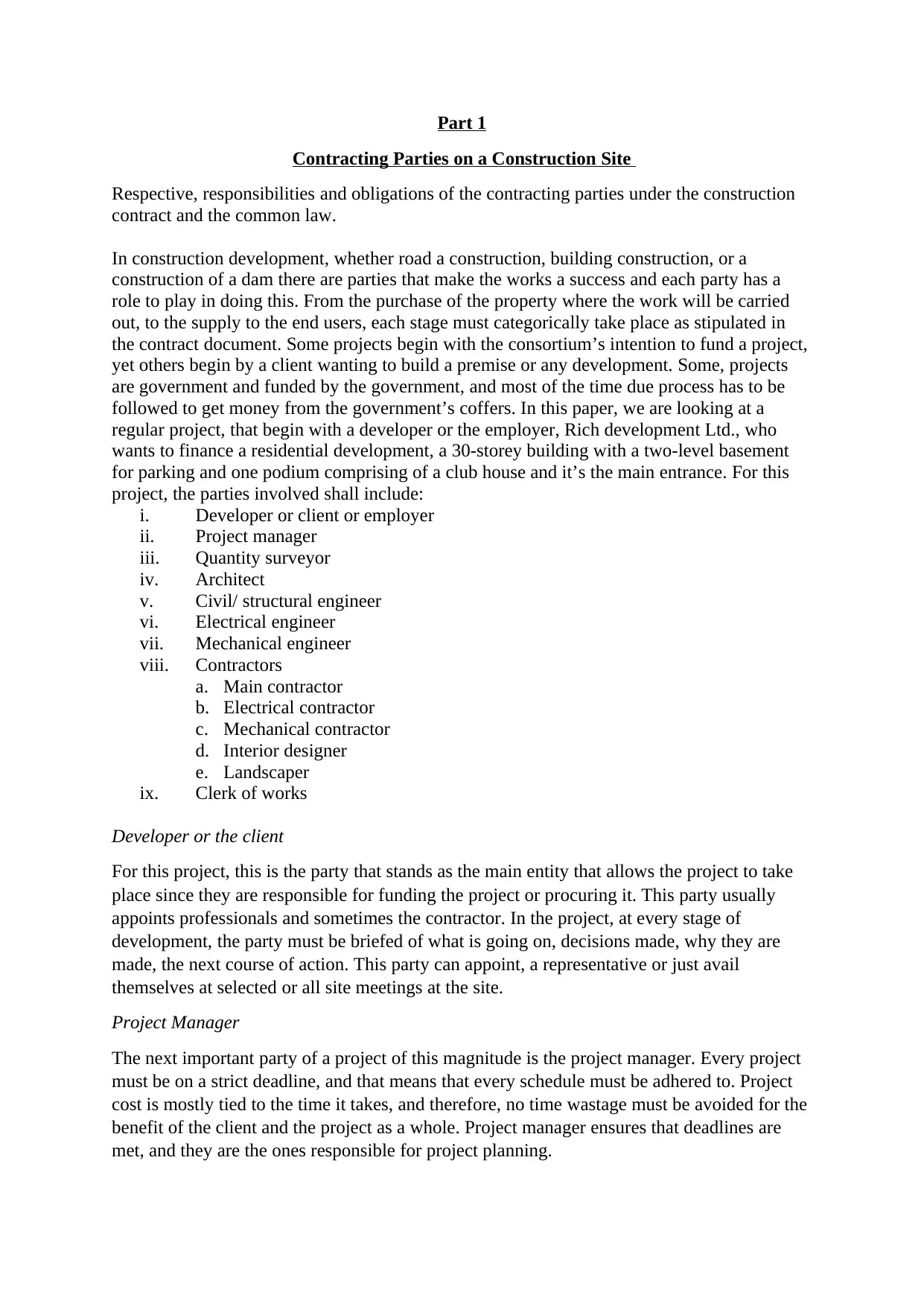
Part 1
Contracting Parties on a Construction Site
Respective, responsibilities and obligations of the contracting parties under the construction
contract and the common law.
In construction development, whether road a construction, building construction, or a
construction of a dam there are parties that make the works a success and each party has a
role to play in doing this. From the purchase of the property where the work will be carried
out, to the supply to the end users, each stage must categorically take place as stipulated in
the contract document. Some projects begin with the consortium’s intention to fund a project,
yet others begin by a client wanting to build a premise or any development. Some, projects
are government and funded by the government, and most of the time due process has to be
followed to get money from the government’s coffers. In this paper, we are looking at a
regular project, that begin with a developer or the employer, Rich development Ltd., who
wants to finance a residential development, a 30-storey building with a two-level basement
for parking and one podium comprising of a club house and it’s the main entrance. For this
project, the parties involved shall include:
i. Developer or client or employer
ii. Project manager
iii. Quantity surveyor
iv. Architect
v. Civil/ structural engineer
vi. Electrical engineer
vii. Mechanical engineer
viii. Contractors
a. Main contractor
b. Electrical contractor
c. Mechanical contractor
d. Interior designer
e. Landscaper
ix. Clerk of works
Developer or the client
For this project, this is the party that stands as the main entity that allows the project to take
place since they are responsible for funding the project or procuring it. This party usually
appoints professionals and sometimes the contractor. In the project, at every stage of
development, the party must be briefed of what is going on, decisions made, why they are
made, the next course of action. This party can appoint, a representative or just avail
themselves at selected or all site meetings at the site.
Project Manager
The next important party of a project of this magnitude is the project manager. Every project
must be on a strict deadline, and that means that every schedule must be adhered to. Project
cost is mostly tied to the time it takes, and therefore, no time wastage must be avoided for the
benefit of the client and the project as a whole. Project manager ensures that deadlines are
met, and they are the ones responsible for project planning.
Contracting Parties on a Construction Site
Respective, responsibilities and obligations of the contracting parties under the construction
contract and the common law.
In construction development, whether road a construction, building construction, or a
construction of a dam there are parties that make the works a success and each party has a
role to play in doing this. From the purchase of the property where the work will be carried
out, to the supply to the end users, each stage must categorically take place as stipulated in
the contract document. Some projects begin with the consortium’s intention to fund a project,
yet others begin by a client wanting to build a premise or any development. Some, projects
are government and funded by the government, and most of the time due process has to be
followed to get money from the government’s coffers. In this paper, we are looking at a
regular project, that begin with a developer or the employer, Rich development Ltd., who
wants to finance a residential development, a 30-storey building with a two-level basement
for parking and one podium comprising of a club house and it’s the main entrance. For this
project, the parties involved shall include:
i. Developer or client or employer
ii. Project manager
iii. Quantity surveyor
iv. Architect
v. Civil/ structural engineer
vi. Electrical engineer
vii. Mechanical engineer
viii. Contractors
a. Main contractor
b. Electrical contractor
c. Mechanical contractor
d. Interior designer
e. Landscaper
ix. Clerk of works
Developer or the client
For this project, this is the party that stands as the main entity that allows the project to take
place since they are responsible for funding the project or procuring it. This party usually
appoints professionals and sometimes the contractor. In the project, at every stage of
development, the party must be briefed of what is going on, decisions made, why they are
made, the next course of action. This party can appoint, a representative or just avail
themselves at selected or all site meetings at the site.
Project Manager
The next important party of a project of this magnitude is the project manager. Every project
must be on a strict deadline, and that means that every schedule must be adhered to. Project
cost is mostly tied to the time it takes, and therefore, no time wastage must be avoided for the
benefit of the client and the project as a whole. Project manager ensures that deadlines are
met, and they are the ones responsible for project planning.
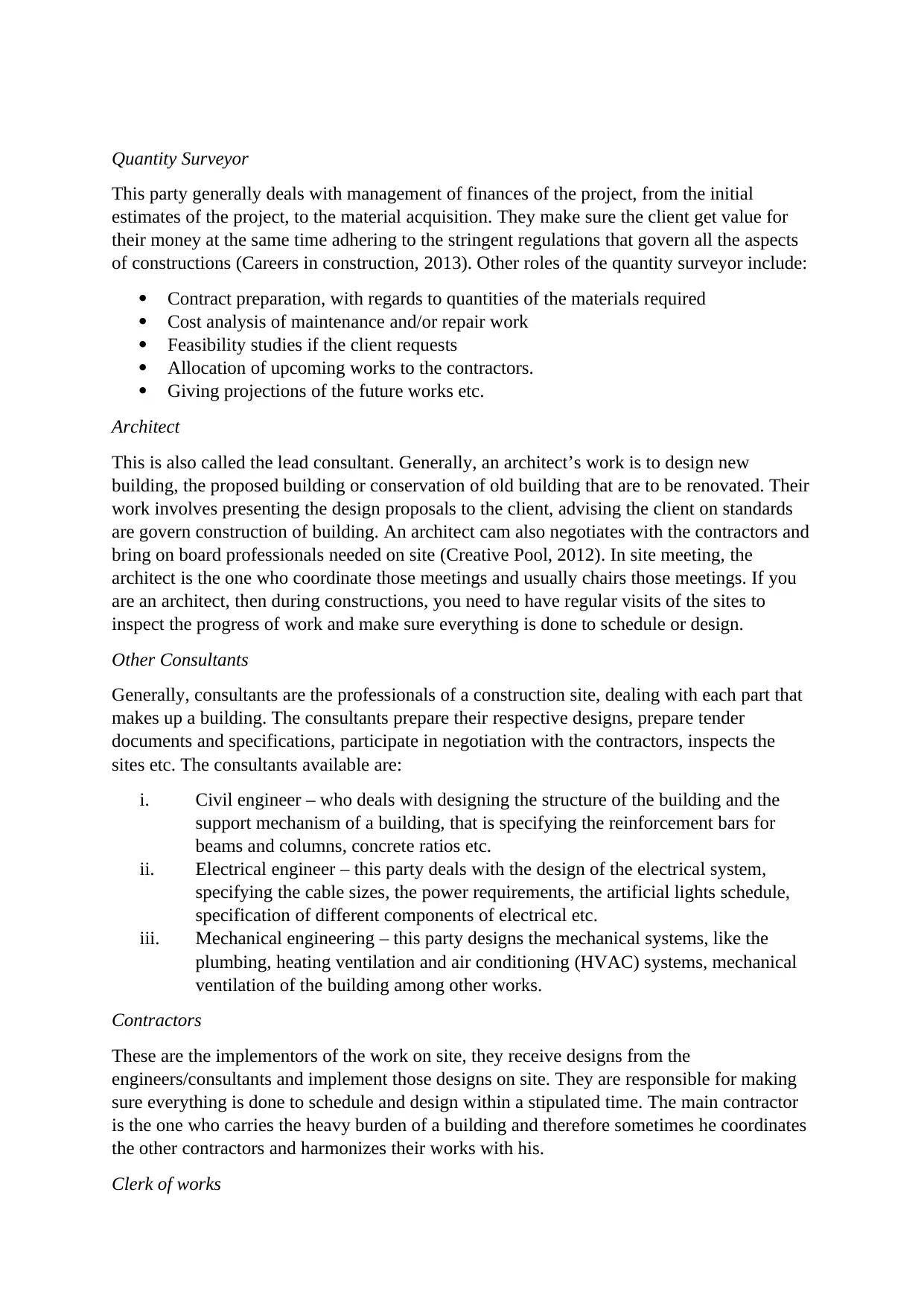
Quantity Surveyor
This party generally deals with management of finances of the project, from the initial
estimates of the project, to the material acquisition. They make sure the client get value for
their money at the same time adhering to the stringent regulations that govern all the aspects
of constructions (Careers in construction, 2013). Other roles of the quantity surveyor include:
Contract preparation, with regards to quantities of the materials required
Cost analysis of maintenance and/or repair work
Feasibility studies if the client requests
Allocation of upcoming works to the contractors.
Giving projections of the future works etc.
Architect
This is also called the lead consultant. Generally, an architect’s work is to design new
building, the proposed building or conservation of old building that are to be renovated. Their
work involves presenting the design proposals to the client, advising the client on standards
are govern construction of building. An architect cam also negotiates with the contractors and
bring on board professionals needed on site (Creative Pool, 2012). In site meeting, the
architect is the one who coordinate those meetings and usually chairs those meetings. If you
are an architect, then during constructions, you need to have regular visits of the sites to
inspect the progress of work and make sure everything is done to schedule or design.
Other Consultants
Generally, consultants are the professionals of a construction site, dealing with each part that
makes up a building. The consultants prepare their respective designs, prepare tender
documents and specifications, participate in negotiation with the contractors, inspects the
sites etc. The consultants available are:
i. Civil engineer – who deals with designing the structure of the building and the
support mechanism of a building, that is specifying the reinforcement bars for
beams and columns, concrete ratios etc.
ii. Electrical engineer – this party deals with the design of the electrical system,
specifying the cable sizes, the power requirements, the artificial lights schedule,
specification of different components of electrical etc.
iii. Mechanical engineering – this party designs the mechanical systems, like the
plumbing, heating ventilation and air conditioning (HVAC) systems, mechanical
ventilation of the building among other works.
Contractors
These are the implementors of the work on site, they receive designs from the
engineers/consultants and implement those designs on site. They are responsible for making
sure everything is done to schedule and design within a stipulated time. The main contractor
is the one who carries the heavy burden of a building and therefore sometimes he coordinates
the other contractors and harmonizes their works with his.
Clerk of works
This party generally deals with management of finances of the project, from the initial
estimates of the project, to the material acquisition. They make sure the client get value for
their money at the same time adhering to the stringent regulations that govern all the aspects
of constructions (Careers in construction, 2013). Other roles of the quantity surveyor include:
Contract preparation, with regards to quantities of the materials required
Cost analysis of maintenance and/or repair work
Feasibility studies if the client requests
Allocation of upcoming works to the contractors.
Giving projections of the future works etc.
Architect
This is also called the lead consultant. Generally, an architect’s work is to design new
building, the proposed building or conservation of old building that are to be renovated. Their
work involves presenting the design proposals to the client, advising the client on standards
are govern construction of building. An architect cam also negotiates with the contractors and
bring on board professionals needed on site (Creative Pool, 2012). In site meeting, the
architect is the one who coordinate those meetings and usually chairs those meetings. If you
are an architect, then during constructions, you need to have regular visits of the sites to
inspect the progress of work and make sure everything is done to schedule or design.
Other Consultants
Generally, consultants are the professionals of a construction site, dealing with each part that
makes up a building. The consultants prepare their respective designs, prepare tender
documents and specifications, participate in negotiation with the contractors, inspects the
sites etc. The consultants available are:
i. Civil engineer – who deals with designing the structure of the building and the
support mechanism of a building, that is specifying the reinforcement bars for
beams and columns, concrete ratios etc.
ii. Electrical engineer – this party deals with the design of the electrical system,
specifying the cable sizes, the power requirements, the artificial lights schedule,
specification of different components of electrical etc.
iii. Mechanical engineering – this party designs the mechanical systems, like the
plumbing, heating ventilation and air conditioning (HVAC) systems, mechanical
ventilation of the building among other works.
Contractors
These are the implementors of the work on site, they receive designs from the
engineers/consultants and implement those designs on site. They are responsible for making
sure everything is done to schedule and design within a stipulated time. The main contractor
is the one who carries the heavy burden of a building and therefore sometimes he coordinates
the other contractors and harmonizes their works with his.
Clerk of works
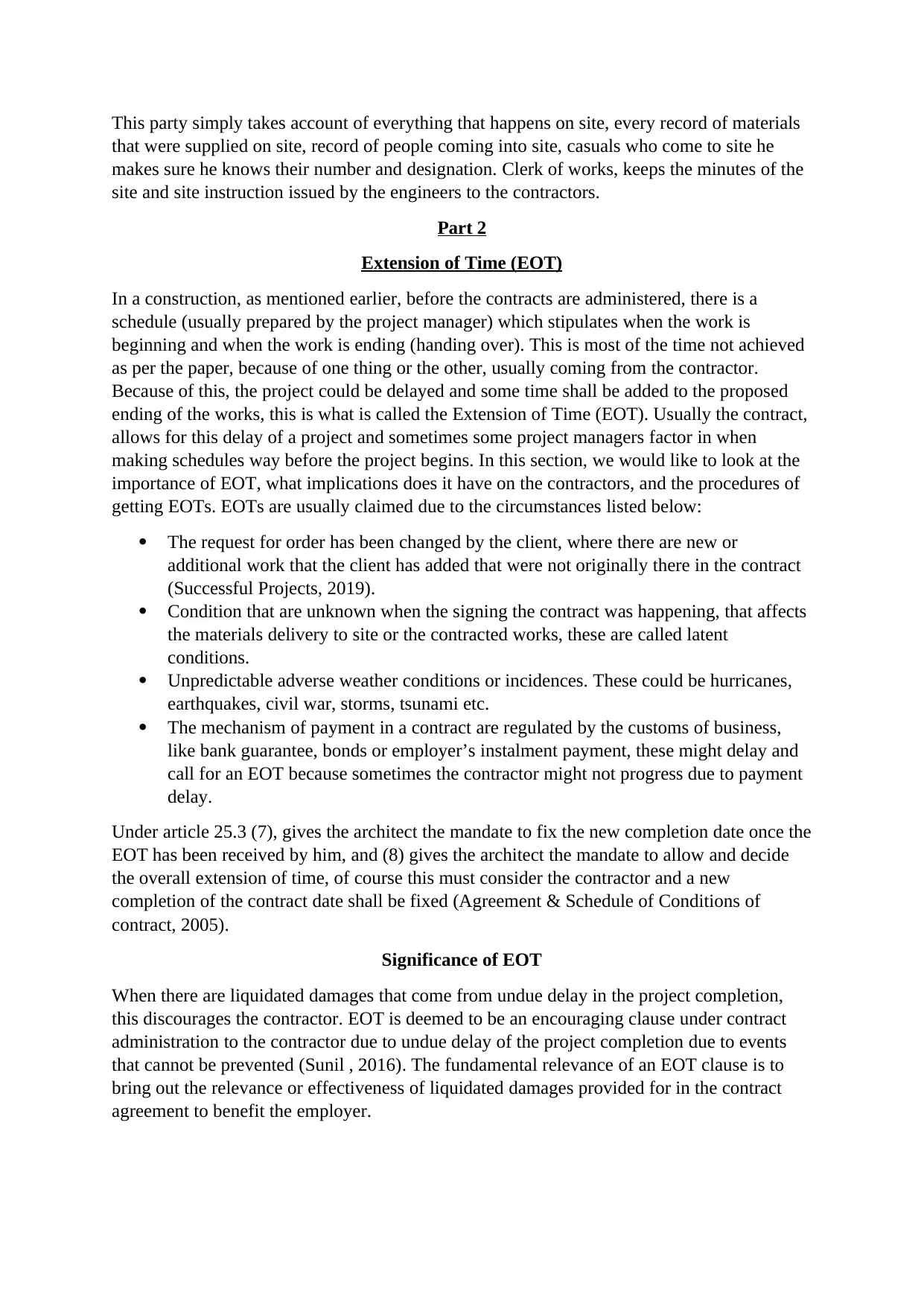
This party simply takes account of everything that happens on site, every record of materials
that were supplied on site, record of people coming into site, casuals who come to site he
makes sure he knows their number and designation. Clerk of works, keeps the minutes of the
site and site instruction issued by the engineers to the contractors.
Part 2
Extension of Time (EOT)
In a construction, as mentioned earlier, before the contracts are administered, there is a
schedule (usually prepared by the project manager) which stipulates when the work is
beginning and when the work is ending (handing over). This is most of the time not achieved
as per the paper, because of one thing or the other, usually coming from the contractor.
Because of this, the project could be delayed and some time shall be added to the proposed
ending of the works, this is what is called the Extension of Time (EOT). Usually the contract,
allows for this delay of a project and sometimes some project managers factor in when
making schedules way before the project begins. In this section, we would like to look at the
importance of EOT, what implications does it have on the contractors, and the procedures of
getting EOTs. EOTs are usually claimed due to the circumstances listed below:
The request for order has been changed by the client, where there are new or
additional work that the client has added that were not originally there in the contract
(Successful Projects, 2019).
Condition that are unknown when the signing the contract was happening, that affects
the materials delivery to site or the contracted works, these are called latent
conditions.
Unpredictable adverse weather conditions or incidences. These could be hurricanes,
earthquakes, civil war, storms, tsunami etc.
The mechanism of payment in a contract are regulated by the customs of business,
like bank guarantee, bonds or employer’s instalment payment, these might delay and
call for an EOT because sometimes the contractor might not progress due to payment
delay.
Under article 25.3 (7), gives the architect the mandate to fix the new completion date once the
EOT has been received by him, and (8) gives the architect the mandate to allow and decide
the overall extension of time, of course this must consider the contractor and a new
completion of the contract date shall be fixed (Agreement & Schedule of Conditions of
contract, 2005).
Significance of EOT
When there are liquidated damages that come from undue delay in the project completion,
this discourages the contractor. EOT is deemed to be an encouraging clause under contract
administration to the contractor due to undue delay of the project completion due to events
that cannot be prevented (Sunil , 2016). The fundamental relevance of an EOT clause is to
bring out the relevance or effectiveness of liquidated damages provided for in the contract
agreement to benefit the employer.
that were supplied on site, record of people coming into site, casuals who come to site he
makes sure he knows their number and designation. Clerk of works, keeps the minutes of the
site and site instruction issued by the engineers to the contractors.
Part 2
Extension of Time (EOT)
In a construction, as mentioned earlier, before the contracts are administered, there is a
schedule (usually prepared by the project manager) which stipulates when the work is
beginning and when the work is ending (handing over). This is most of the time not achieved
as per the paper, because of one thing or the other, usually coming from the contractor.
Because of this, the project could be delayed and some time shall be added to the proposed
ending of the works, this is what is called the Extension of Time (EOT). Usually the contract,
allows for this delay of a project and sometimes some project managers factor in when
making schedules way before the project begins. In this section, we would like to look at the
importance of EOT, what implications does it have on the contractors, and the procedures of
getting EOTs. EOTs are usually claimed due to the circumstances listed below:
The request for order has been changed by the client, where there are new or
additional work that the client has added that were not originally there in the contract
(Successful Projects, 2019).
Condition that are unknown when the signing the contract was happening, that affects
the materials delivery to site or the contracted works, these are called latent
conditions.
Unpredictable adverse weather conditions or incidences. These could be hurricanes,
earthquakes, civil war, storms, tsunami etc.
The mechanism of payment in a contract are regulated by the customs of business,
like bank guarantee, bonds or employer’s instalment payment, these might delay and
call for an EOT because sometimes the contractor might not progress due to payment
delay.
Under article 25.3 (7), gives the architect the mandate to fix the new completion date once the
EOT has been received by him, and (8) gives the architect the mandate to allow and decide
the overall extension of time, of course this must consider the contractor and a new
completion of the contract date shall be fixed (Agreement & Schedule of Conditions of
contract, 2005).
Significance of EOT
When there are liquidated damages that come from undue delay in the project completion,
this discourages the contractor. EOT is deemed to be an encouraging clause under contract
administration to the contractor due to undue delay of the project completion due to events
that cannot be prevented (Sunil , 2016). The fundamental relevance of an EOT clause is to
bring out the relevance or effectiveness of liquidated damages provided for in the contract
agreement to benefit the employer.
Secure Best Marks with AI Grader
Need help grading? Try our AI Grader for instant feedback on your assignments.
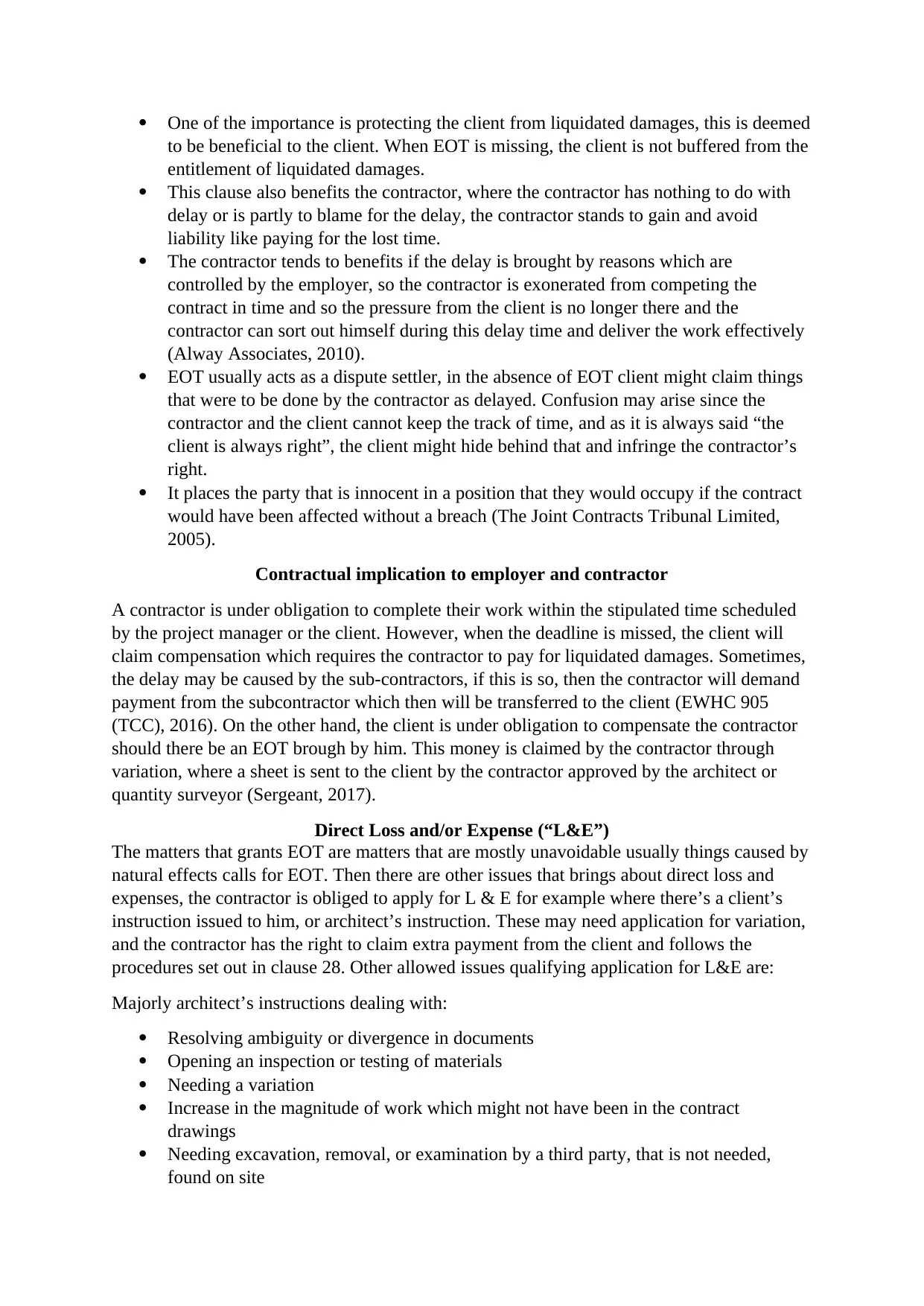
One of the importance is protecting the client from liquidated damages, this is deemed
to be beneficial to the client. When EOT is missing, the client is not buffered from the
entitlement of liquidated damages.
This clause also benefits the contractor, where the contractor has nothing to do with
delay or is partly to blame for the delay, the contractor stands to gain and avoid
liability like paying for the lost time.
The contractor tends to benefits if the delay is brought by reasons which are
controlled by the employer, so the contractor is exonerated from competing the
contract in time and so the pressure from the client is no longer there and the
contractor can sort out himself during this delay time and deliver the work effectively
(Alway Associates, 2010).
EOT usually acts as a dispute settler, in the absence of EOT client might claim things
that were to be done by the contractor as delayed. Confusion may arise since the
contractor and the client cannot keep the track of time, and as it is always said “the
client is always right”, the client might hide behind that and infringe the contractor’s
right.
It places the party that is innocent in a position that they would occupy if the contract
would have been affected without a breach (The Joint Contracts Tribunal Limited,
2005).
Contractual implication to employer and contractor
A contractor is under obligation to complete their work within the stipulated time scheduled
by the project manager or the client. However, when the deadline is missed, the client will
claim compensation which requires the contractor to pay for liquidated damages. Sometimes,
the delay may be caused by the sub-contractors, if this is so, then the contractor will demand
payment from the subcontractor which then will be transferred to the client (EWHC 905
(TCC), 2016). On the other hand, the client is under obligation to compensate the contractor
should there be an EOT brough by him. This money is claimed by the contractor through
variation, where a sheet is sent to the client by the contractor approved by the architect or
quantity surveyor (Sergeant, 2017).
Direct Loss and/or Expense (“L&E”)
The matters that grants EOT are matters that are mostly unavoidable usually things caused by
natural effects calls for EOT. Then there are other issues that brings about direct loss and
expenses, the contractor is obliged to apply for L & E for example where there’s a client’s
instruction issued to him, or architect’s instruction. These may need application for variation,
and the contractor has the right to claim extra payment from the client and follows the
procedures set out in clause 28. Other allowed issues qualifying application for L&E are:
Majorly architect’s instructions dealing with:
Resolving ambiguity or divergence in documents
Opening an inspection or testing of materials
Needing a variation
Increase in the magnitude of work which might not have been in the contract
drawings
Needing excavation, removal, or examination by a third party, that is not needed,
found on site
to be beneficial to the client. When EOT is missing, the client is not buffered from the
entitlement of liquidated damages.
This clause also benefits the contractor, where the contractor has nothing to do with
delay or is partly to blame for the delay, the contractor stands to gain and avoid
liability like paying for the lost time.
The contractor tends to benefits if the delay is brought by reasons which are
controlled by the employer, so the contractor is exonerated from competing the
contract in time and so the pressure from the client is no longer there and the
contractor can sort out himself during this delay time and deliver the work effectively
(Alway Associates, 2010).
EOT usually acts as a dispute settler, in the absence of EOT client might claim things
that were to be done by the contractor as delayed. Confusion may arise since the
contractor and the client cannot keep the track of time, and as it is always said “the
client is always right”, the client might hide behind that and infringe the contractor’s
right.
It places the party that is innocent in a position that they would occupy if the contract
would have been affected without a breach (The Joint Contracts Tribunal Limited,
2005).
Contractual implication to employer and contractor
A contractor is under obligation to complete their work within the stipulated time scheduled
by the project manager or the client. However, when the deadline is missed, the client will
claim compensation which requires the contractor to pay for liquidated damages. Sometimes,
the delay may be caused by the sub-contractors, if this is so, then the contractor will demand
payment from the subcontractor which then will be transferred to the client (EWHC 905
(TCC), 2016). On the other hand, the client is under obligation to compensate the contractor
should there be an EOT brough by him. This money is claimed by the contractor through
variation, where a sheet is sent to the client by the contractor approved by the architect or
quantity surveyor (Sergeant, 2017).
Direct Loss and/or Expense (“L&E”)
The matters that grants EOT are matters that are mostly unavoidable usually things caused by
natural effects calls for EOT. Then there are other issues that brings about direct loss and
expenses, the contractor is obliged to apply for L & E for example where there’s a client’s
instruction issued to him, or architect’s instruction. These may need application for variation,
and the contractor has the right to claim extra payment from the client and follows the
procedures set out in clause 28. Other allowed issues qualifying application for L&E are:
Majorly architect’s instructions dealing with:
Resolving ambiguity or divergence in documents
Opening an inspection or testing of materials
Needing a variation
Increase in the magnitude of work which might not have been in the contract
drawings
Needing excavation, removal, or examination by a third party, that is not needed,
found on site
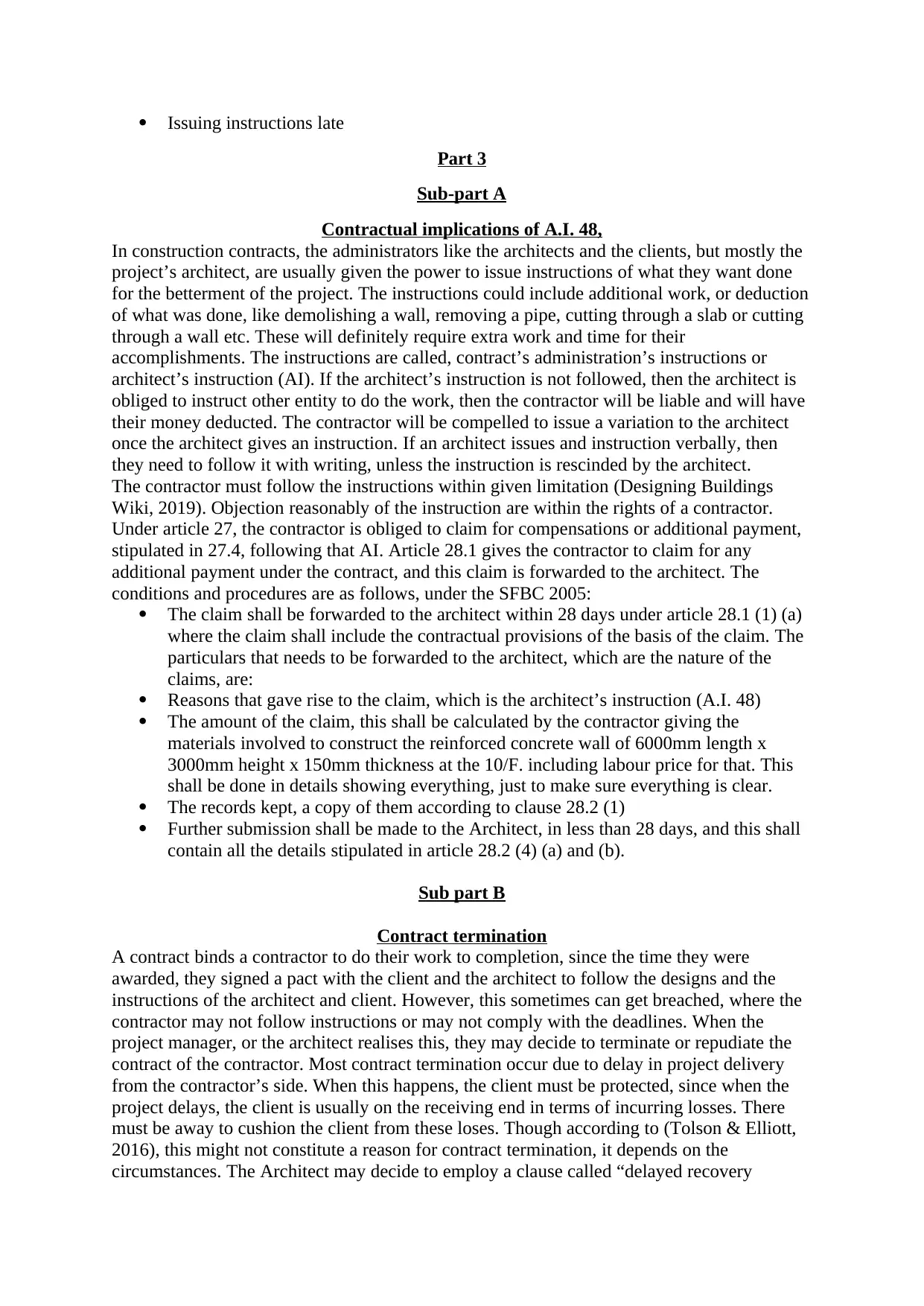
Issuing instructions late
Part 3
Sub-part A
Contractual implications of A.I. 48,
In construction contracts, the administrators like the architects and the clients, but mostly the
project’s architect, are usually given the power to issue instructions of what they want done
for the betterment of the project. The instructions could include additional work, or deduction
of what was done, like demolishing a wall, removing a pipe, cutting through a slab or cutting
through a wall etc. These will definitely require extra work and time for their
accomplishments. The instructions are called, contract’s administration’s instructions or
architect’s instruction (AI). If the architect’s instruction is not followed, then the architect is
obliged to instruct other entity to do the work, then the contractor will be liable and will have
their money deducted. The contractor will be compelled to issue a variation to the architect
once the architect gives an instruction. If an architect issues and instruction verbally, then
they need to follow it with writing, unless the instruction is rescinded by the architect.
The contractor must follow the instructions within given limitation (Designing Buildings
Wiki, 2019). Objection reasonably of the instruction are within the rights of a contractor.
Under article 27, the contractor is obliged to claim for compensations or additional payment,
stipulated in 27.4, following that AI. Article 28.1 gives the contractor to claim for any
additional payment under the contract, and this claim is forwarded to the architect. The
conditions and procedures are as follows, under the SFBC 2005:
The claim shall be forwarded to the architect within 28 days under article 28.1 (1) (a)
where the claim shall include the contractual provisions of the basis of the claim. The
particulars that needs to be forwarded to the architect, which are the nature of the
claims, are:
Reasons that gave rise to the claim, which is the architect’s instruction (A.I. 48)
The amount of the claim, this shall be calculated by the contractor giving the
materials involved to construct the reinforced concrete wall of 6000mm length x
3000mm height x 150mm thickness at the 10/F. including labour price for that. This
shall be done in details showing everything, just to make sure everything is clear.
The records kept, a copy of them according to clause 28.2 (1)
Further submission shall be made to the Architect, in less than 28 days, and this shall
contain all the details stipulated in article 28.2 (4) (a) and (b).
Sub part B
Contract termination
A contract binds a contractor to do their work to completion, since the time they were
awarded, they signed a pact with the client and the architect to follow the designs and the
instructions of the architect and client. However, this sometimes can get breached, where the
contractor may not follow instructions or may not comply with the deadlines. When the
project manager, or the architect realises this, they may decide to terminate or repudiate the
contract of the contractor. Most contract termination occur due to delay in project delivery
from the contractor’s side. When this happens, the client must be protected, since when the
project delays, the client is usually on the receiving end in terms of incurring losses. There
must be away to cushion the client from these loses. Though according to (Tolson & Elliott,
2016), this might not constitute a reason for contract termination, it depends on the
circumstances. The Architect may decide to employ a clause called “delayed recovery
Part 3
Sub-part A
Contractual implications of A.I. 48,
In construction contracts, the administrators like the architects and the clients, but mostly the
project’s architect, are usually given the power to issue instructions of what they want done
for the betterment of the project. The instructions could include additional work, or deduction
of what was done, like demolishing a wall, removing a pipe, cutting through a slab or cutting
through a wall etc. These will definitely require extra work and time for their
accomplishments. The instructions are called, contract’s administration’s instructions or
architect’s instruction (AI). If the architect’s instruction is not followed, then the architect is
obliged to instruct other entity to do the work, then the contractor will be liable and will have
their money deducted. The contractor will be compelled to issue a variation to the architect
once the architect gives an instruction. If an architect issues and instruction verbally, then
they need to follow it with writing, unless the instruction is rescinded by the architect.
The contractor must follow the instructions within given limitation (Designing Buildings
Wiki, 2019). Objection reasonably of the instruction are within the rights of a contractor.
Under article 27, the contractor is obliged to claim for compensations or additional payment,
stipulated in 27.4, following that AI. Article 28.1 gives the contractor to claim for any
additional payment under the contract, and this claim is forwarded to the architect. The
conditions and procedures are as follows, under the SFBC 2005:
The claim shall be forwarded to the architect within 28 days under article 28.1 (1) (a)
where the claim shall include the contractual provisions of the basis of the claim. The
particulars that needs to be forwarded to the architect, which are the nature of the
claims, are:
Reasons that gave rise to the claim, which is the architect’s instruction (A.I. 48)
The amount of the claim, this shall be calculated by the contractor giving the
materials involved to construct the reinforced concrete wall of 6000mm length x
3000mm height x 150mm thickness at the 10/F. including labour price for that. This
shall be done in details showing everything, just to make sure everything is clear.
The records kept, a copy of them according to clause 28.2 (1)
Further submission shall be made to the Architect, in less than 28 days, and this shall
contain all the details stipulated in article 28.2 (4) (a) and (b).
Sub part B
Contract termination
A contract binds a contractor to do their work to completion, since the time they were
awarded, they signed a pact with the client and the architect to follow the designs and the
instructions of the architect and client. However, this sometimes can get breached, where the
contractor may not follow instructions or may not comply with the deadlines. When the
project manager, or the architect realises this, they may decide to terminate or repudiate the
contract of the contractor. Most contract termination occur due to delay in project delivery
from the contractor’s side. When this happens, the client must be protected, since when the
project delays, the client is usually on the receiving end in terms of incurring losses. There
must be away to cushion the client from these loses. Though according to (Tolson & Elliott,
2016), this might not constitute a reason for contract termination, it depends on the
circumstances. The Architect may decide to employ a clause called “delayed recovery
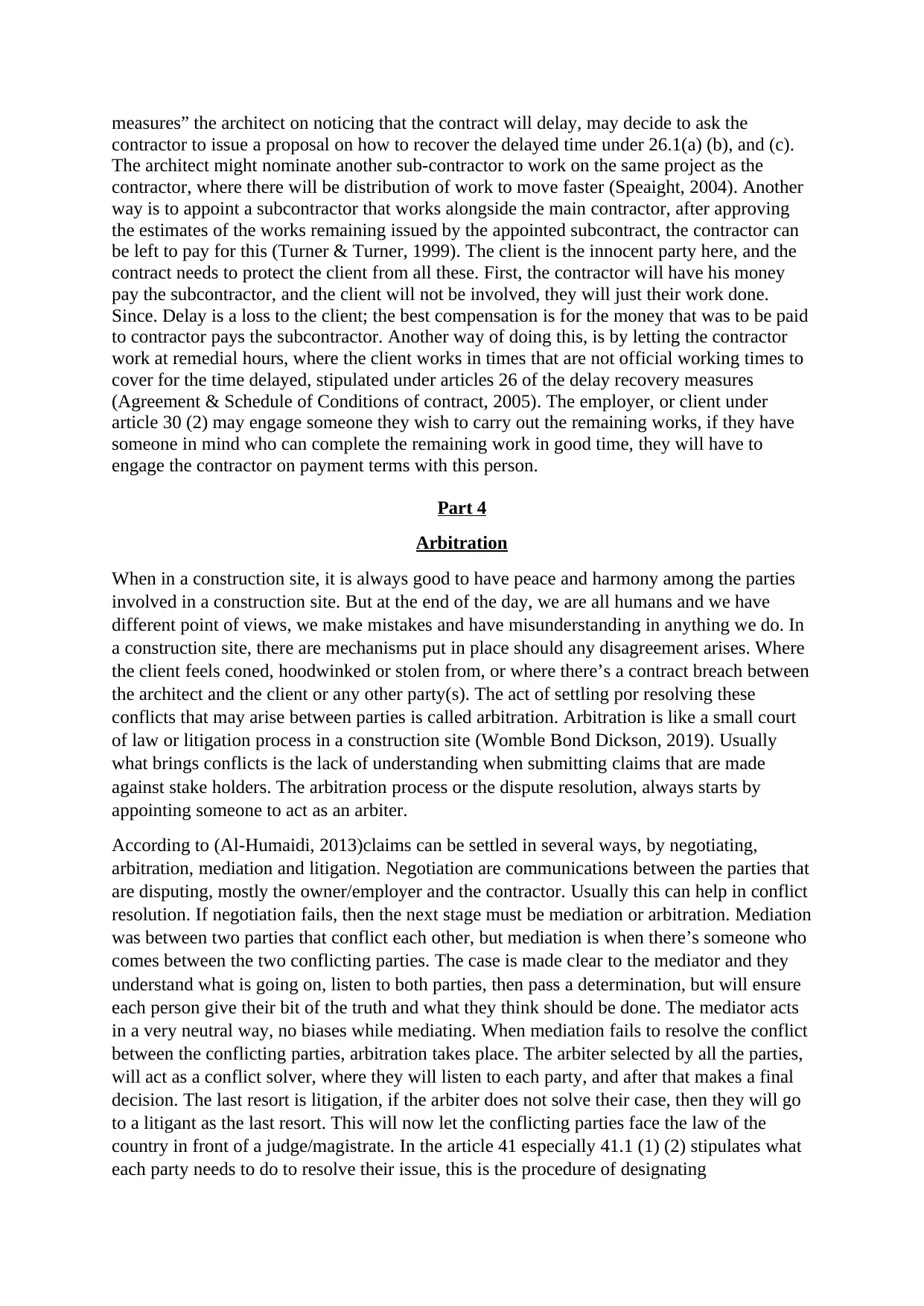
measures” the architect on noticing that the contract will delay, may decide to ask the
contractor to issue a proposal on how to recover the delayed time under 26.1(a) (b), and (c).
The architect might nominate another sub-contractor to work on the same project as the
contractor, where there will be distribution of work to move faster (Speaight, 2004). Another
way is to appoint a subcontractor that works alongside the main contractor, after approving
the estimates of the works remaining issued by the appointed subcontract, the contractor can
be left to pay for this (Turner & Turner, 1999). The client is the innocent party here, and the
contract needs to protect the client from all these. First, the contractor will have his money
pay the subcontractor, and the client will not be involved, they will just their work done.
Since. Delay is a loss to the client; the best compensation is for the money that was to be paid
to contractor pays the subcontractor. Another way of doing this, is by letting the contractor
work at remedial hours, where the client works in times that are not official working times to
cover for the time delayed, stipulated under articles 26 of the delay recovery measures
(Agreement & Schedule of Conditions of contract, 2005). The employer, or client under
article 30 (2) may engage someone they wish to carry out the remaining works, if they have
someone in mind who can complete the remaining work in good time, they will have to
engage the contractor on payment terms with this person.
Part 4
Arbitration
When in a construction site, it is always good to have peace and harmony among the parties
involved in a construction site. But at the end of the day, we are all humans and we have
different point of views, we make mistakes and have misunderstanding in anything we do. In
a construction site, there are mechanisms put in place should any disagreement arises. Where
the client feels coned, hoodwinked or stolen from, or where there’s a contract breach between
the architect and the client or any other party(s). The act of settling por resolving these
conflicts that may arise between parties is called arbitration. Arbitration is like a small court
of law or litigation process in a construction site (Womble Bond Dickson, 2019). Usually
what brings conflicts is the lack of understanding when submitting claims that are made
against stake holders. The arbitration process or the dispute resolution, always starts by
appointing someone to act as an arbiter.
According to (Al-Humaidi, 2013)claims can be settled in several ways, by negotiating,
arbitration, mediation and litigation. Negotiation are communications between the parties that
are disputing, mostly the owner/employer and the contractor. Usually this can help in conflict
resolution. If negotiation fails, then the next stage must be mediation or arbitration. Mediation
was between two parties that conflict each other, but mediation is when there’s someone who
comes between the two conflicting parties. The case is made clear to the mediator and they
understand what is going on, listen to both parties, then pass a determination, but will ensure
each person give their bit of the truth and what they think should be done. The mediator acts
in a very neutral way, no biases while mediating. When mediation fails to resolve the conflict
between the conflicting parties, arbitration takes place. The arbiter selected by all the parties,
will act as a conflict solver, where they will listen to each party, and after that makes a final
decision. The last resort is litigation, if the arbiter does not solve their case, then they will go
to a litigant as the last resort. This will now let the conflicting parties face the law of the
country in front of a judge/magistrate. In the article 41 especially 41.1 (1) (2) stipulates what
each party needs to do to resolve their issue, this is the procedure of designating
contractor to issue a proposal on how to recover the delayed time under 26.1(a) (b), and (c).
The architect might nominate another sub-contractor to work on the same project as the
contractor, where there will be distribution of work to move faster (Speaight, 2004). Another
way is to appoint a subcontractor that works alongside the main contractor, after approving
the estimates of the works remaining issued by the appointed subcontract, the contractor can
be left to pay for this (Turner & Turner, 1999). The client is the innocent party here, and the
contract needs to protect the client from all these. First, the contractor will have his money
pay the subcontractor, and the client will not be involved, they will just their work done.
Since. Delay is a loss to the client; the best compensation is for the money that was to be paid
to contractor pays the subcontractor. Another way of doing this, is by letting the contractor
work at remedial hours, where the client works in times that are not official working times to
cover for the time delayed, stipulated under articles 26 of the delay recovery measures
(Agreement & Schedule of Conditions of contract, 2005). The employer, or client under
article 30 (2) may engage someone they wish to carry out the remaining works, if they have
someone in mind who can complete the remaining work in good time, they will have to
engage the contractor on payment terms with this person.
Part 4
Arbitration
When in a construction site, it is always good to have peace and harmony among the parties
involved in a construction site. But at the end of the day, we are all humans and we have
different point of views, we make mistakes and have misunderstanding in anything we do. In
a construction site, there are mechanisms put in place should any disagreement arises. Where
the client feels coned, hoodwinked or stolen from, or where there’s a contract breach between
the architect and the client or any other party(s). The act of settling por resolving these
conflicts that may arise between parties is called arbitration. Arbitration is like a small court
of law or litigation process in a construction site (Womble Bond Dickson, 2019). Usually
what brings conflicts is the lack of understanding when submitting claims that are made
against stake holders. The arbitration process or the dispute resolution, always starts by
appointing someone to act as an arbiter.
According to (Al-Humaidi, 2013)claims can be settled in several ways, by negotiating,
arbitration, mediation and litigation. Negotiation are communications between the parties that
are disputing, mostly the owner/employer and the contractor. Usually this can help in conflict
resolution. If negotiation fails, then the next stage must be mediation or arbitration. Mediation
was between two parties that conflict each other, but mediation is when there’s someone who
comes between the two conflicting parties. The case is made clear to the mediator and they
understand what is going on, listen to both parties, then pass a determination, but will ensure
each person give their bit of the truth and what they think should be done. The mediator acts
in a very neutral way, no biases while mediating. When mediation fails to resolve the conflict
between the conflicting parties, arbitration takes place. The arbiter selected by all the parties,
will act as a conflict solver, where they will listen to each party, and after that makes a final
decision. The last resort is litigation, if the arbiter does not solve their case, then they will go
to a litigant as the last resort. This will now let the conflicting parties face the law of the
country in front of a judge/magistrate. In the article 41 especially 41.1 (1) (2) stipulates what
each party needs to do to resolve their issue, this is the procedure of designating
Paraphrase This Document
Need a fresh take? Get an instant paraphrase of this document with our AI Paraphraser
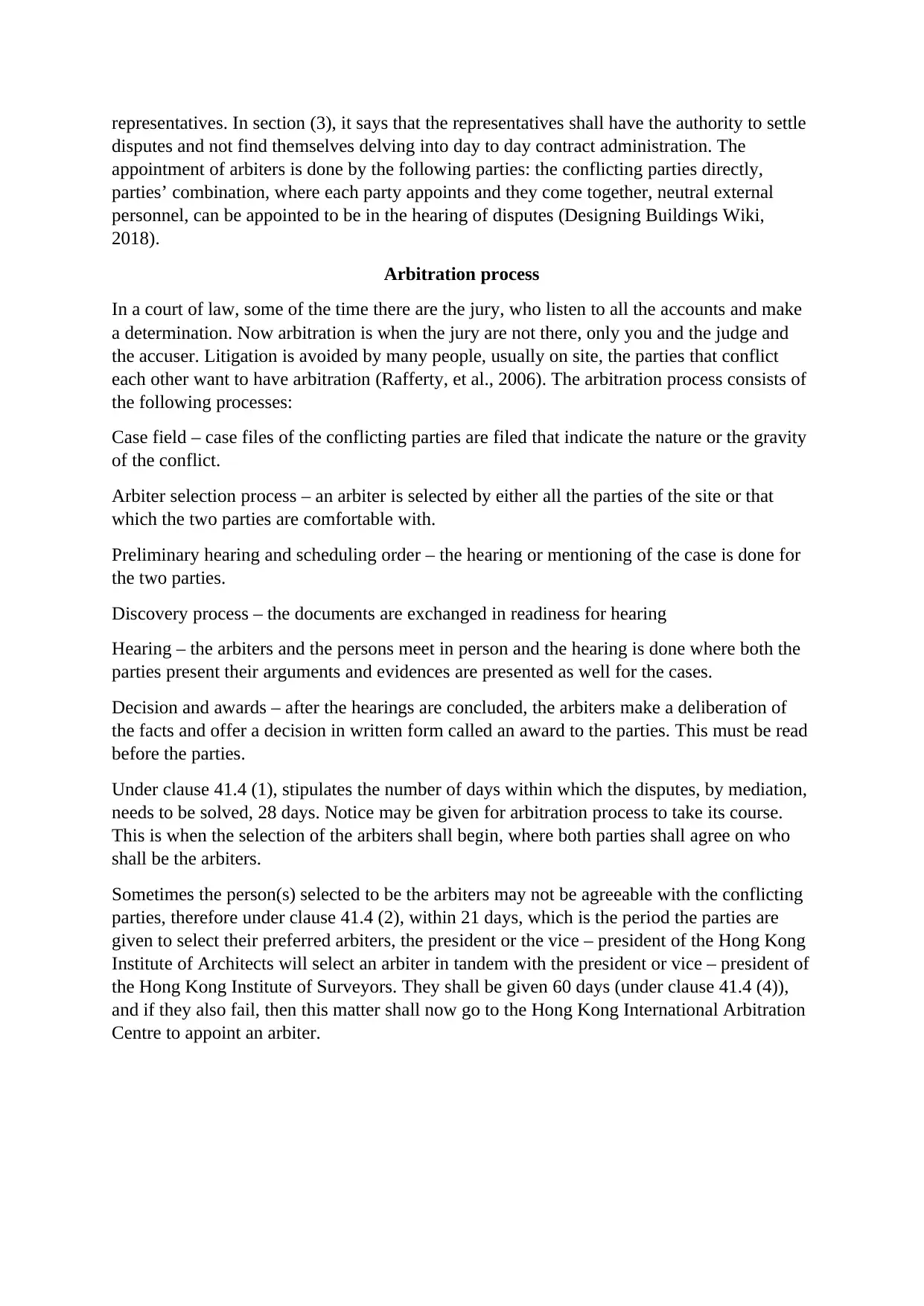
representatives. In section (3), it says that the representatives shall have the authority to settle
disputes and not find themselves delving into day to day contract administration. The
appointment of arbiters is done by the following parties: the conflicting parties directly,
parties’ combination, where each party appoints and they come together, neutral external
personnel, can be appointed to be in the hearing of disputes (Designing Buildings Wiki,
2018).
Arbitration process
In a court of law, some of the time there are the jury, who listen to all the accounts and make
a determination. Now arbitration is when the jury are not there, only you and the judge and
the accuser. Litigation is avoided by many people, usually on site, the parties that conflict
each other want to have arbitration (Rafferty, et al., 2006). The arbitration process consists of
the following processes:
Case field – case files of the conflicting parties are filed that indicate the nature or the gravity
of the conflict.
Arbiter selection process – an arbiter is selected by either all the parties of the site or that
which the two parties are comfortable with.
Preliminary hearing and scheduling order – the hearing or mentioning of the case is done for
the two parties.
Discovery process – the documents are exchanged in readiness for hearing
Hearing – the arbiters and the persons meet in person and the hearing is done where both the
parties present their arguments and evidences are presented as well for the cases.
Decision and awards – after the hearings are concluded, the arbiters make a deliberation of
the facts and offer a decision in written form called an award to the parties. This must be read
before the parties.
Under clause 41.4 (1), stipulates the number of days within which the disputes, by mediation,
needs to be solved, 28 days. Notice may be given for arbitration process to take its course.
This is when the selection of the arbiters shall begin, where both parties shall agree on who
shall be the arbiters.
Sometimes the person(s) selected to be the arbiters may not be agreeable with the conflicting
parties, therefore under clause 41.4 (2), within 21 days, which is the period the parties are
given to select their preferred arbiters, the president or the vice – president of the Hong Kong
Institute of Architects will select an arbiter in tandem with the president or vice – president of
the Hong Kong Institute of Surveyors. They shall be given 60 days (under clause 41.4 (4)),
and if they also fail, then this matter shall now go to the Hong Kong International Arbitration
Centre to appoint an arbiter.
disputes and not find themselves delving into day to day contract administration. The
appointment of arbiters is done by the following parties: the conflicting parties directly,
parties’ combination, where each party appoints and they come together, neutral external
personnel, can be appointed to be in the hearing of disputes (Designing Buildings Wiki,
2018).
Arbitration process
In a court of law, some of the time there are the jury, who listen to all the accounts and make
a determination. Now arbitration is when the jury are not there, only you and the judge and
the accuser. Litigation is avoided by many people, usually on site, the parties that conflict
each other want to have arbitration (Rafferty, et al., 2006). The arbitration process consists of
the following processes:
Case field – case files of the conflicting parties are filed that indicate the nature or the gravity
of the conflict.
Arbiter selection process – an arbiter is selected by either all the parties of the site or that
which the two parties are comfortable with.
Preliminary hearing and scheduling order – the hearing or mentioning of the case is done for
the two parties.
Discovery process – the documents are exchanged in readiness for hearing
Hearing – the arbiters and the persons meet in person and the hearing is done where both the
parties present their arguments and evidences are presented as well for the cases.
Decision and awards – after the hearings are concluded, the arbiters make a deliberation of
the facts and offer a decision in written form called an award to the parties. This must be read
before the parties.
Under clause 41.4 (1), stipulates the number of days within which the disputes, by mediation,
needs to be solved, 28 days. Notice may be given for arbitration process to take its course.
This is when the selection of the arbiters shall begin, where both parties shall agree on who
shall be the arbiters.
Sometimes the person(s) selected to be the arbiters may not be agreeable with the conflicting
parties, therefore under clause 41.4 (2), within 21 days, which is the period the parties are
given to select their preferred arbiters, the president or the vice – president of the Hong Kong
Institute of Architects will select an arbiter in tandem with the president or vice – president of
the Hong Kong Institute of Surveyors. They shall be given 60 days (under clause 41.4 (4)),
and if they also fail, then this matter shall now go to the Hong Kong International Arbitration
Centre to appoint an arbiter.
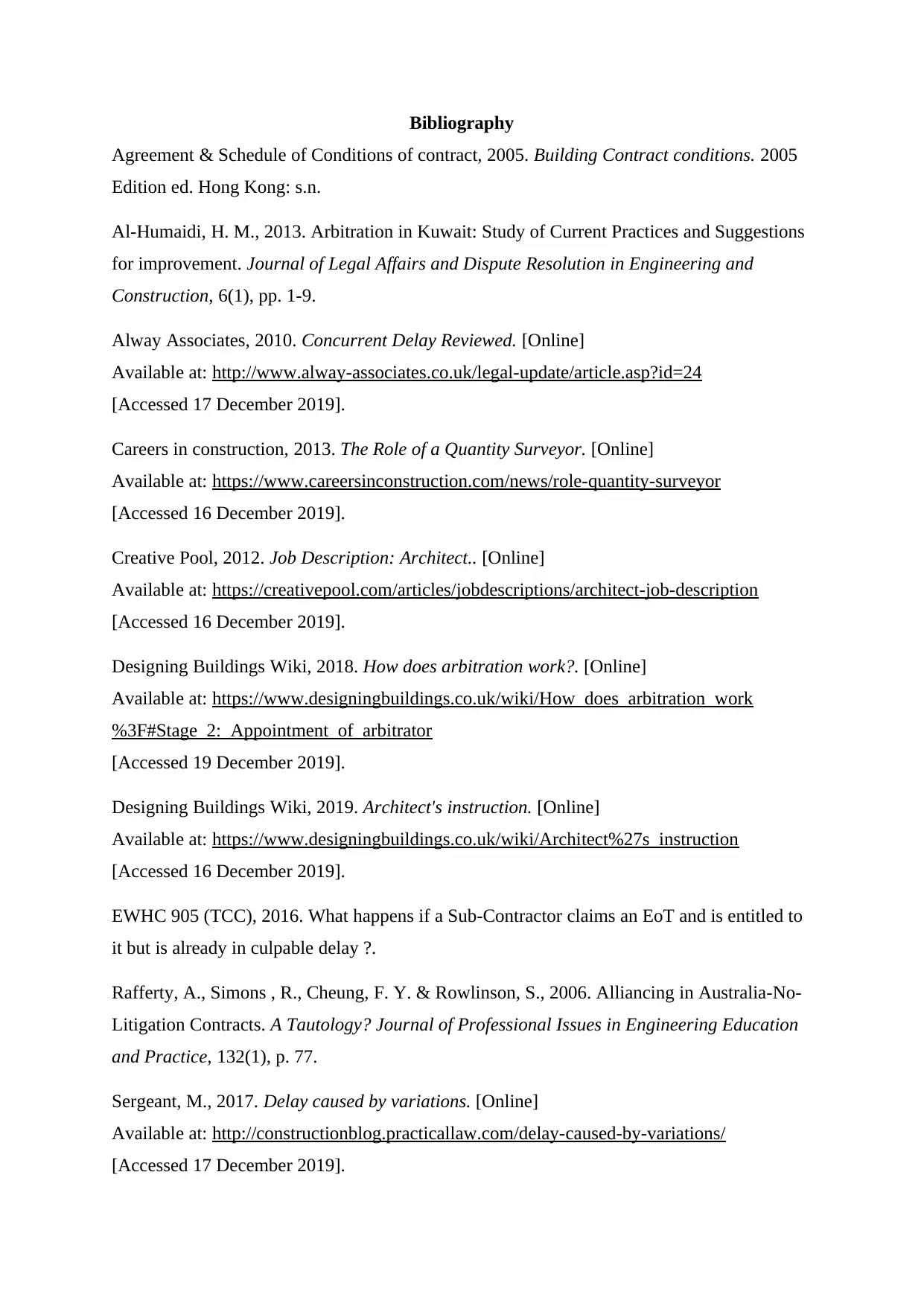
Bibliography
Agreement & Schedule of Conditions of contract, 2005. Building Contract conditions. 2005
Edition ed. Hong Kong: s.n.
Al-Humaidi, H. M., 2013. Arbitration in Kuwait: Study of Current Practices and Suggestions
for improvement. Journal of Legal Affairs and Dispute Resolution in Engineering and
Construction, 6(1), pp. 1-9.
Alway Associates, 2010. Concurrent Delay Reviewed. [Online]
Available at: http://www.alway-associates.co.uk/legal-update/article.asp?id=24
[Accessed 17 December 2019].
Careers in construction, 2013. The Role of a Quantity Surveyor. [Online]
Available at: https://www.careersinconstruction.com/news/role-quantity-surveyor
[Accessed 16 December 2019].
Creative Pool, 2012. Job Description: Architect.. [Online]
Available at: https://creativepool.com/articles/jobdescriptions/architect-job-description
[Accessed 16 December 2019].
Designing Buildings Wiki, 2018. How does arbitration work?. [Online]
Available at: https://www.designingbuildings.co.uk/wiki/How_does_arbitration_work
%3F#Stage_2:_Appointment_of_arbitrator
[Accessed 19 December 2019].
Designing Buildings Wiki, 2019. Architect's instruction. [Online]
Available at: https://www.designingbuildings.co.uk/wiki/Architect%27s_instruction
[Accessed 16 December 2019].
EWHC 905 (TCC), 2016. What happens if a Sub-Contractor claims an EoT and is entitled to
it but is already in culpable delay ?.
Rafferty, A., Simons , R., Cheung, F. Y. & Rowlinson, S., 2006. Alliancing in Australia-No-
Litigation Contracts. A Tautology? Journal of Professional Issues in Engineering Education
and Practice, 132(1), p. 77.
Sergeant, M., 2017. Delay caused by variations. [Online]
Available at: http://constructionblog.practicallaw.com/delay-caused-by-variations/
[Accessed 17 December 2019].
Agreement & Schedule of Conditions of contract, 2005. Building Contract conditions. 2005
Edition ed. Hong Kong: s.n.
Al-Humaidi, H. M., 2013. Arbitration in Kuwait: Study of Current Practices and Suggestions
for improvement. Journal of Legal Affairs and Dispute Resolution in Engineering and
Construction, 6(1), pp. 1-9.
Alway Associates, 2010. Concurrent Delay Reviewed. [Online]
Available at: http://www.alway-associates.co.uk/legal-update/article.asp?id=24
[Accessed 17 December 2019].
Careers in construction, 2013. The Role of a Quantity Surveyor. [Online]
Available at: https://www.careersinconstruction.com/news/role-quantity-surveyor
[Accessed 16 December 2019].
Creative Pool, 2012. Job Description: Architect.. [Online]
Available at: https://creativepool.com/articles/jobdescriptions/architect-job-description
[Accessed 16 December 2019].
Designing Buildings Wiki, 2018. How does arbitration work?. [Online]
Available at: https://www.designingbuildings.co.uk/wiki/How_does_arbitration_work
%3F#Stage_2:_Appointment_of_arbitrator
[Accessed 19 December 2019].
Designing Buildings Wiki, 2019. Architect's instruction. [Online]
Available at: https://www.designingbuildings.co.uk/wiki/Architect%27s_instruction
[Accessed 16 December 2019].
EWHC 905 (TCC), 2016. What happens if a Sub-Contractor claims an EoT and is entitled to
it but is already in culpable delay ?.
Rafferty, A., Simons , R., Cheung, F. Y. & Rowlinson, S., 2006. Alliancing in Australia-No-
Litigation Contracts. A Tautology? Journal of Professional Issues in Engineering Education
and Practice, 132(1), p. 77.
Sergeant, M., 2017. Delay caused by variations. [Online]
Available at: http://constructionblog.practicallaw.com/delay-caused-by-variations/
[Accessed 17 December 2019].
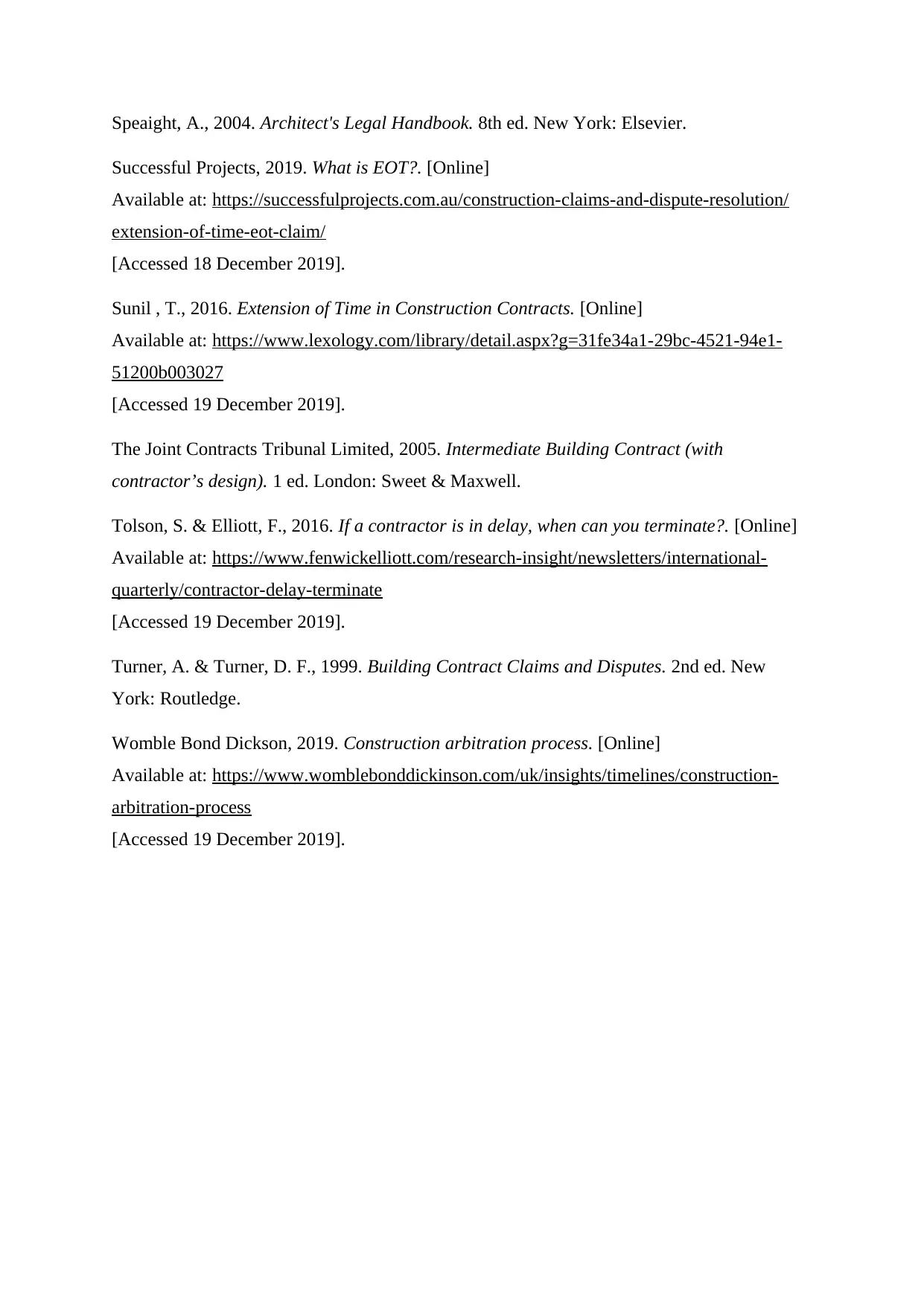
Speaight, A., 2004. Architect's Legal Handbook. 8th ed. New York: Elsevier.
Successful Projects, 2019. What is EOT?. [Online]
Available at: https://successfulprojects.com.au/construction-claims-and-dispute-resolution/
extension-of-time-eot-claim/
[Accessed 18 December 2019].
Sunil , T., 2016. Extension of Time in Construction Contracts. [Online]
Available at: https://www.lexology.com/library/detail.aspx?g=31fe34a1-29bc-4521-94e1-
51200b003027
[Accessed 19 December 2019].
The Joint Contracts Tribunal Limited, 2005. Intermediate Building Contract (with
contractor’s design). 1 ed. London: Sweet & Maxwell.
Tolson, S. & Elliott, F., 2016. If a contractor is in delay, when can you terminate?. [Online]
Available at: https://www.fenwickelliott.com/research-insight/newsletters/international-
quarterly/contractor-delay-terminate
[Accessed 19 December 2019].
Turner, A. & Turner, D. F., 1999. Building Contract Claims and Disputes. 2nd ed. New
York: Routledge.
Womble Bond Dickson, 2019. Construction arbitration process. [Online]
Available at: https://www.womblebonddickinson.com/uk/insights/timelines/construction-
arbitration-process
[Accessed 19 December 2019].
Successful Projects, 2019. What is EOT?. [Online]
Available at: https://successfulprojects.com.au/construction-claims-and-dispute-resolution/
extension-of-time-eot-claim/
[Accessed 18 December 2019].
Sunil , T., 2016. Extension of Time in Construction Contracts. [Online]
Available at: https://www.lexology.com/library/detail.aspx?g=31fe34a1-29bc-4521-94e1-
51200b003027
[Accessed 19 December 2019].
The Joint Contracts Tribunal Limited, 2005. Intermediate Building Contract (with
contractor’s design). 1 ed. London: Sweet & Maxwell.
Tolson, S. & Elliott, F., 2016. If a contractor is in delay, when can you terminate?. [Online]
Available at: https://www.fenwickelliott.com/research-insight/newsletters/international-
quarterly/contractor-delay-terminate
[Accessed 19 December 2019].
Turner, A. & Turner, D. F., 1999. Building Contract Claims and Disputes. 2nd ed. New
York: Routledge.
Womble Bond Dickson, 2019. Construction arbitration process. [Online]
Available at: https://www.womblebonddickinson.com/uk/insights/timelines/construction-
arbitration-process
[Accessed 19 December 2019].
Secure Best Marks with AI Grader
Need help grading? Try our AI Grader for instant feedback on your assignments.

1 out of 11
Related Documents
Your All-in-One AI-Powered Toolkit for Academic Success.
+13062052269
info@desklib.com
Available 24*7 on WhatsApp / Email
![[object Object]](/_next/static/media/star-bottom.7253800d.svg)
Unlock your academic potential
© 2024 | Zucol Services PVT LTD | All rights reserved.





